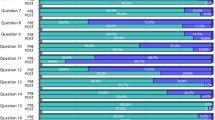Abstract
Consumers’ autonomy regarding health increasingly requires competences to critically appraise health information. Critical health literacy refers to the concept of evidence-based medicine. Instruments to measure these competences in curriculum evaluation and surveys are lacking. We aimed to develop and validate an instrument to measure critical health competences (CHC test). Development and testing of the questionnaire covered three phases: (1) test construction (and feasibility, (2) first field test of scalability and items revision (3) second field test to validate the instrument. Model fit analyses were performed for both field tests for Rasch-, Mixed Rasch- and Hybrid model. Participants were secondary school and university students with and without prior training in evidence-based medicine (1. field test n = 322; with training n = 87; 2. field test n = 107; with training n = 13). The second field test resulted in Rasch scalability of all items in one person class. Mean values (±SD) of person parameters were 716.14 (±53.74) for trained students and 470.11 (±59.63) for untrained students. Reliability of the instrument was 0.91 (WINMIRA ANOVA). In conclusion the CHC instrument is a feasible, reliable and valid instrument to measure critical health literacy. The generalizability of the instrument is to be explored in ongoing studies in different educational settings.

Similar content being viewed by others
References
Berger, B., Meyer, G., Steckelberg, A., & Mühlhauser, I. (2007). Are laypersons able to learn and to use evidence-based medicine (EbM) skills? Paper presented at the 4th International Shared Decision Making Conference “Shared decision-making in diverse health care systems: Translating research into practice”, Freiburg, Germany.
Deutsches PISA-Konsortium (2001). PISA Basiskompetenzen von Schüler-innen und Schülern im internationalen Vergleich. Opladen: Leske und Budrich.
Dickersin, K., Braun, L., Mead, M., Millikan, R., Wu, A. M., Pietenpol, J., Troyan, S., Anderson, B., & Visco, F. (2001). Development and implementation of a science training course for breast cancer activists: Project LEAD (leadership, education and advocacy development). Health Expectations, 4, 213–220.
European Network of Health Promoting Schools. (2004). The European Network of Health Promoting Schools – the alliance of education and health. Retrieved August 20, 2005: http://www.euro.who.int/document/e62361.pdf
Hoijtink, H., & Boomsma, A. (1995). On person parameter estimation in the dichotomous Rasch model. In G. H. Fischer & I. Molenaar (Eds.), Rasch models: Foundations, recent developments and applications. New York: Springer.
Lynagh, M., Perkins, J., & Schofield, M. (2002). An evidence-based approach to health promoting schools. The Journal of school health, 72, 300–302.
Max Planck Institute for Human Development (Ed.) (2000). Third International Mathematics and Science Study – TIMSS. Retrieved October 1, 2005 from Max Planck Institute for Human Development Web site: http://www.timss.mpg.de/
Milne, R., & Oliver, S. (1996). Evidence-based consumer health information: Developing teaching in critical appraisal skills. International Journal for Quality in Health Care, 8, 439–445.
Nutbeam, D. (2000). Health literacy as a public health goal: A challenge for contemporary health education and communication strategies into the 21st century. Health Promotion International, 15, 259–267.
Rosenfeld, P., Salazar-Riera, N., & Vieir, D. (2002). Piloting an information literacy programme for staff nurses: Lessons learned. Computers Informatics, Nursing, 20, 236–241.
Rost, J. (2004). Lehrbuch Testtheorie – Testkonstruktion. Bern: Huber.
Rost, J., & von Davier, M. (1994). A conditional item fix index for Rasch models. Applied Psychological Measurement, 18(2), 171–182.
Shaneyfelt, T., Baum, K. D., Bell, D., Feldstein, D., Houston, T. K., Kaatz, S., Whelan, C., & Green, M. (2006). Instruments for evaluating education in evidence-based practice: A systematic review. JAMA: The Journal of the American Medical Association, 296(9), 1116–1127.
Simonds, S. K. (1977). Health education today: Issues and challenges. The Journal of School Health, 47(10), 584–593.
Steckelberg, A., Hülfenhaus, C., & Mühlhauser, I. (2006) Ebm@school: Ein Curriculum zur Kompetenzentwicklung von critical health literacy. Welche Interessen haben Schülerinnen und Schüler Allgemeinbildender Schulen? Poster presented at the 7th Annual Meeting of the German Network for Evidence Based Medicine, Bochum.
Taking health literacy seriously (Editorial) (2005). Lancet, 366, 95.
von Davier, M. (2001). WINMIRA: A software for analyses with a variety of discrete mixture distribution models for dichotomous and polytomous categorical data (Germany).
Warm, T. A. (1989). Weighted likelihood estimation of ability in item response models. Psychometrica, 54, 427–450.
Yamamoto, K. (1989). A Hybrid model of IRT and latent class models. ETS Research Report (RR-89-41). Princeton, NJ: Educational Testing Service.
Acknowledgements
We thank Anke Fuhlendorf for participating in the process of item construction and also for project administration. We also acknowledge the contribution made by all the participating students. We also thank the principles and teachers for supporting this project. In addition we thank the Institute for Quality and Efficiency in Health Care, Cologne, Germany, for funding this project.
Author information
Authors and Affiliations
Corresponding author
Rights and permissions
About this article
Cite this article
Steckelberg, A., Hülfenhaus, C., Kasper, J. et al. How to measure critical health competences: development and validation of the Critical Health Competence Test (CHC Test). Adv in Health Sci Educ 14, 11–22 (2009). https://doi.org/10.1007/s10459-007-9083-1
Received:
Accepted:
Published:
Issue Date:
DOI: https://doi.org/10.1007/s10459-007-9083-1




